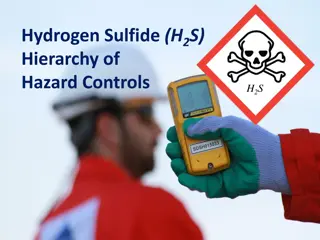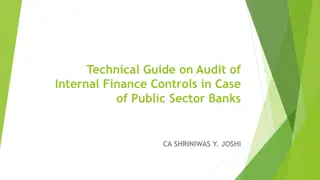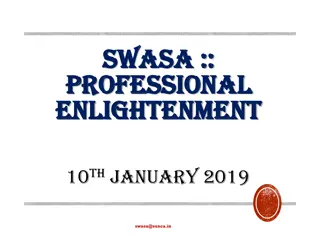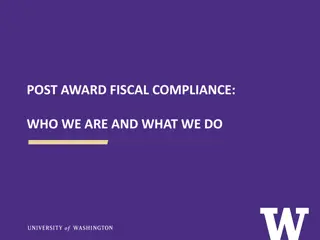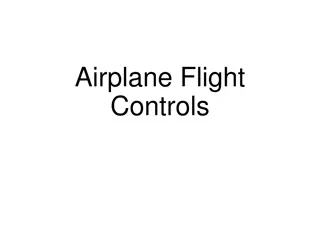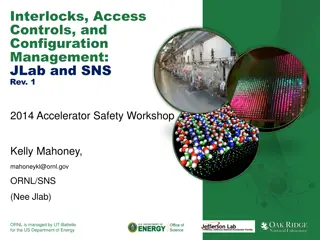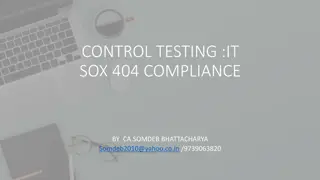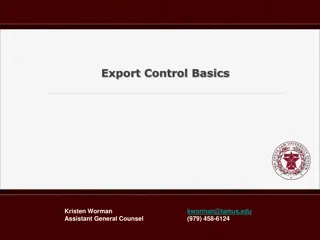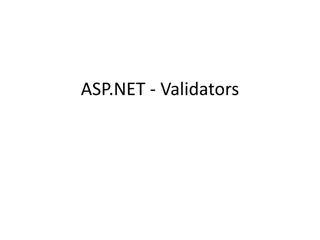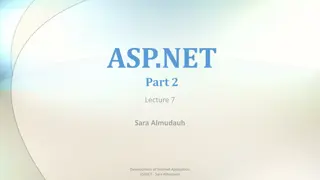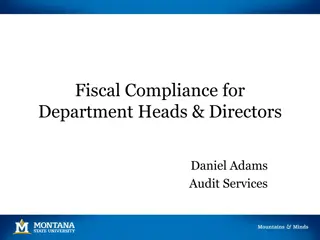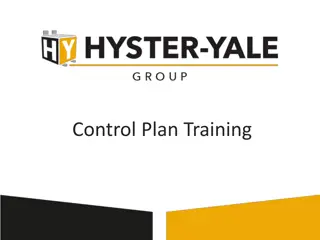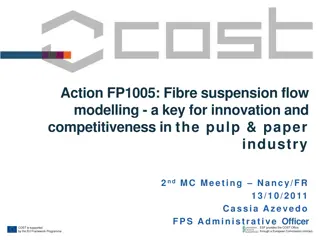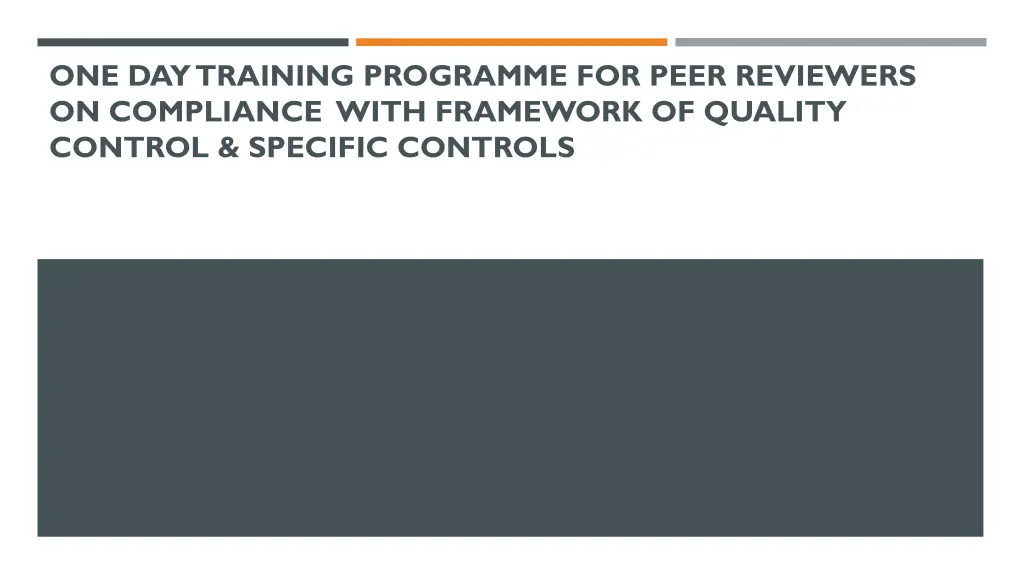
One Day Training Programme for Peer Reviewers on Compliance with Quality Control Framework
Enhance your skills in compliance with quality control frameworks through a comprehensive one-day training programme for peer reviewers. Gain insights on specific controls, standards on QC, and the importance of upholding professional standards. This session is essential for audit firms and professionals looking to improve the quality of their work in line with regulatory and legal requirements.
Download Presentation

Please find below an Image/Link to download the presentation.
The content on the website is provided AS IS for your information and personal use only. It may not be sold, licensed, or shared on other websites without obtaining consent from the author. If you encounter any issues during the download, it is possible that the publisher has removed the file from their server.
You are allowed to download the files provided on this website for personal or commercial use, subject to the condition that they are used lawfully. All files are the property of their respective owners.
The content on the website is provided AS IS for your information and personal use only. It may not be sold, licensed, or shared on other websites without obtaining consent from the author.
E N D
Presentation Transcript
ONE DAY TRAINING PROGRAMME FOR PEER REVIEWERS ON COMPLIANCE WITH FRAMEWORK OF QUALITY CONTROL & SPECIFIC CONTROLS
2 RESTRICTIONS OF USE The views expressed are those of the presenter and, therefore, do not necessarily represent the views of either the Council of the Institute of Chartered Accountants of India (ICAI) or any Committee(s)/Board(s) thereof
STANDARD ON QC (SQC) 1 QC FOR FIRMS THAT PERFORM AUDITS AND REVIEWS OF HISTORICAL FINANCIAL INFORMATION, AND OTHER ASSURANCE AND RELATED SERVICES ENGAGEMENTS
4 WHY THIS SESSION? Over the last decade or so, regulators all over the world have been commenting adversely on the quality of work done by audit firms and there is a general perception that we, as a collective body are not interested in quality of work but are perhaps driven largely by commercial considerations The profession is at cross-roads The profession must collectively address this issue without which there will be no future
5 SYNOPSIS Purpose is to establish standards and provide guidance regarding a firm s responsibilities for its system of QC for audits, reviews of historical financial information, for other assurance and related services engagements. SQC is to be read in conjunction with the requirements of the Chartered Accountants Act, 1949, the Code of Ethics and other relevant pronouncements of the Institute The firm should establish a system of QC designed to provide it with reasonable assurance that the firm and its personnel comply with professional standards and regulatory/legal requirements, and that reports issued by the firm/engagement partner(s) are appropriate in the circumstances. SQC applies to all firms with varied nature of policies/ procedures depending upon various factors such as the size and operating characteristics of the firm, and whether it is part of a network.
6 DEFINITIONS Engagement documentation: the record of work performed, results obtained, and conclusions reached thereon (also known as workingpapers ) Engagement partner: the partner or other person in the firm responsible for the engagement Engagement QC review: a process designed to provide an objective evaluation, before the report is issued, of the significant judgments the engagement team made, and the conclusions reached thereon Engagement QC reviewer: a partner, other person in the firm, suitably qualified external person, or a team made up of such individuals, with sufficient and appropriate experience and authority to objectively evaluate, before the report is issued, the significant judgments the engagement team made, and the conclusions reached thereon. Engagement team: all personnel performing an engagement, including any experts contracted in connection with that engagement.
7 DEFINITIONS Monitoring:a process comprising an ongoing consideration and evaluation of the firm s system of QC, including a periodic inspection of a selection of completed engagements, designed to enable the firm to obtain reasonable assurance that its system of QC is operating effectively Network and Network firm: A firm or entity that belongs to a network Network: A larger structure that is aimed at cooperation, and clearly aimed at profit or cost-sharing or shares common ownership, control or management, common QC policies and procedures, common business strategy, the use of a common brand name, or a significant part of professional resources Professional standards: Engagement standards and relevant ethical requirements as contained in the Code Suitably qualified external person: For example, a partner or an employee (with appropriate experience) of another firm.
8 ELEMENTS OF A SYSTEM OF QC The firm s system of QC should include policies and procedures addressing each of the following elements: Leadership responsibilities for quality within the firm. 1. Ethical requirements. 2. Acceptance and continuance of client relationships and specific engagements. 3. Human resources. 4. Engagement performance. 5. Monitoring. 6. The firm s personnel shall be communicated with above including objectives they achieve, message that everyone has a personal responsibility for quality and is expected to comply with these policies and procedures. In addition, the firm recognizes the importance of obtaining feedback on its QC system from its personnel.
9 ELEMENT 1: LEADERSHIP RESPONSIBILITIES FOR QUALITY WITHIN THE FIRM Objective is to establish policies and procedures designed to promote an internal culture. CEO/ Managing partners/ equivalent to assume ultimate responsibility for the firm s system of QC. They may be communicated by training seminars, meetings, formal or informal dialogue, mission statements, newsletters, or briefing memoranda. They are incorporated in the firm s internal documentation and training materials, and in partner/ staff appraisal procedures such that they will support and reinforce the firm s view on the importance of quality and how, practically, it is to be achieved. Person assigned operational responsibility for the firm s QC system should have sufficient and appropriate experience/ability/authority, to assume that responsibility. This enables the responsible person to identify and understand issues, develop and implement appropriate policies/procedures.
10 ELEMENT 1: LEADERSHIP RESPONSIBILITIES FOR QUALITY WITHIN THE FIRM Managing Partner to assume ultimate responsibility Design, implementation and operating effectiveness of QC Educating professional personnel Commercial considerations do not override the quality MP to continually evaluate client relationships and specific engagements Emphasizing to personnel that fee considerations and scope of service should not infringe QC Responsibility for developing, implementing, and operating QC Performance evaluation, compensation, and advancement with regard to personnel MP to designate a QC Partner Compensation system to take into consideration firm s feedback and reward partners and personnel for timely identification of significant and emerging issues Sufficient and appropriate resources for support of its QC Designated QC to be provided sufficient time and resources QC documentation to be provided to personnel Timely review of QC policies
11 ELEMENT 2: ETHICAL REQUIREMENTS Design policies & procedures to provide reasonable assurance that the firm and its personnel comply with following ethical requirements Integrity Objectivity Professional competence and due care Confidentiality Professional behavior
12 ELEMENT 2: ETHICAL REQUIREMENTS Threats to independence to be identified, assessed, and appropriate safeguards applied to eliminate or reduce the following threats to an acceptable level. Else, the firm to consider withdrawing from the engagement. Self interest threat Self review threat Advocacy threat Familiarity threat Intimidation threat
13 ELEMENT 2: ETHICAL REQUIREMENTS the threat that a financial or other interest will inappropriately influence a professional accountant s judgment or behavior Self-interest threats previous judgment needs to be re-evaluated by the professional accountant responsible for that judgment. Self-review threats professional accountant promotes a position or opinion to the point that subsequent objectivity may be compromised. Advocacy threats due to a long or close relationship with a client, or employing organization, being too sympathetic to their interests or too accepting of their work Familiarity threats Intimidation threats deterred from acting objectively by threats, actual or perceived.
14 ELEMENT 2: ETHICAL REQUIREMENTS Some examples of safeguards that might be applied are: Involving an additional partner or professional staff member to carry out reviews of work done or to otherwise advise as necessary. This individual could be someone in another Firm or someone within the Firm who was not otherwise associated with the audit. Rotation of senior partners or professional staff (Set out criteria for determining the need for safeguards to reduce the familiarity threat when using the same senior personnel over a long period of time. For audits listed entities, rotation of the engagement partner after a specified period. Normally not more than seven years in case of partners Discussing independence issues with the auditee's audit committee or those charged with governance. Withdrawal from an engagement if safeguards to reduce threats to independence to an acceptable level cannot be applied Procedures for confirming the independence of another Firm that performs part of the engagement
15 ELEMENT 2: ETHICAL REQUIREMENTS Firm to establish policies and procedures to provide reasonable assurance that the firm, its personnel and, where applicable, others subject to independence requirements (including experts contracted by the firm and network firm personnel), maintain independence where required by the Code. Such policies and procedures should enable the firm to: Communicate its independence requirements to its personnel and, where applicable, to others subject to them; and Identify and evaluate circumstances and relationships that create threats to independence, and to take appropriate action to eliminate those threats or reduce them to an acceptable level by applying safeguards, or, if considered appropriate, to withdraw from the engagement.
16 ELEMENT 2: ETHICAL REQUIREMENTS Such policies and procedures should require: Engagement partners to provide firm with relevant information about client engagements, including scope of services, to enable the firm to evaluate the overall impact, if any, on independence requirements Personnel to promptly notify the firm of circumstances/relationships that create a threat to independence so that appropriate action can be taken The accumulation and communication of relevant information to appropriate personnel so that The firm and its personnel can readily determine whether they satisfy independence requirements The firm can maintain and update its records relating to independence The firm can take appropriate action regarding identified threats to independence
17 ELEMENT 2: ETHICAL REQUIREMENTS Establish policies and procedures designed to provide it with reasonable assurance that it is notified of breaches of independence requirements, and to enable it to take appropriate actions to resolve such situations. The policies and procedures should include requirements for All who are subject to independence requirements to promptly notify the firm of independence breaches of which they become aware The firm to promptly communicate identified breaches of these policies and procedures to The engagement partner who, with the firm, needs to address the breach Other relevant personnel in the firm and those subject to independence requirements who need to take appropriate action At least annually, the firm should obtain written confirmation of compliance with its policies and procedures on independence from all firm personnel required to be independent in terms of the requirements of the Code.
18 ELEMENT 2: ETHICAL REQUIREMENTS Policies and Procedures Personnel adherence to ethical requirements MP to designate Independence and Ethics partner Establishing system for identifying all services performed for all clients Regularly consulting ICAI s journal and website Ensuring training attendance Informing personnel of their responsibilities Providing frequent reminders Partner to consider relevant information about client engagements Providing training to partners and professional staff Accumulating and communicating information Personnel to promptly report threats to independence Communicating identified breaches and corrective actions Periodic review of unpaid fees from clients Documenting the threats Establish procedures to communicate independence requirements Establish procedures to identify and evaluate possible threats to independence
19 ELEMENT 2: ETHICAL REQUIREMENTS Withdraw if safeguard to reduce threats to independence acceptable level cannot be applied Consulting within firm and legal counsel to an Obtain written confirmation at least annually of independence Establish procedures for confirmation of independence of another firm performing part of engagement Review representations and resolve reported exceptions compliance on Using practice aids prescribing form and content of independence representations
20 ELEMENT 3: ACCEPTANCE AND CONTINUANCE OF CLIENT RELATIONSHIPS AND SPECIFIC ENGAGEMENTS Design policies and procedures to provide reasonable assurance that it will undertake or continue relationships and engagements only where: It has considered integrity of client and does not have information that would lead it to conclude that client lacks integrity It is competent to perform the engagement and has the capabilities, time and resources to do so It can comply with the ethical requirements The Firm should obtain such information as it considers necessary: before accepting an engagement with a new client when deciding whether to continue an existing client relationship and/or engagement when considering acceptance of a new engagement with an existing client In case issues have been identified and firm decides to accept or continue client relationship/ specific engagement, it should document how the issues were resolved
21 ELEMENT 3: ACCEPTANCE AND CONTINUANCE OF CLIENT RELATIONSHIPS AND SPECIFIC ENGAGEMENTS With regard to the integrity of a client, matters that the firm considers include, for example: The identity and business reputation of client s principal owners, key management, related parties. The nature of the client s operations, including its business practices. Information concerning the attitude of client s principal owners, key management and TCWG towards such matters as aggressive interpretation of accounting standards and the internal control environment. Whether the client is aggressively concerned with maintaining the firm s fees as low as possible. Indications of inappropriate limitation in the scope of work, client might be involved in money laundering or other criminal activities The reasons for the proposed appointment of the firm and non- reappointment of the previous firm. The extent of knowledge a firm will have regarding the integrity of a client will generally grow within the context of an ongoing relationship with that client.
22 ELEMENT 3: ACCEPTANCE AND CONTINUANCE OF CLIENT RELATIONSHIPS AND SPECIFIC ENGAGEMENTS Information on such matters that the firm obtains may come from, for example: Communications with existing or previous providers of professional accountancy services to the client in accordance with the Code, and discussions with other third parties. Inquiry of other firm personnel or third parties such as bankers, legal counsel and industry peers. Background searches of relevant databases. Independence confirmation
23 ELEMENT 3: ACCEPTANCE AND CONTINUANCE OF CLIENT RELATIONSHIPS AND SPECIFIC ENGAGEMENTS In considering whether the firm has the capabilities, competence, time and resources to undertake a new engagement from a new or an existing client, the firm reviews the specific requirements of the engagement and existing partner and staff profiles at all relevant levels. Matters the firm considers include whether: Firm personnel have knowledge of relevant industries or subject matters Firm personnel have experience with relevant regulatory or reporting requirements, or the ability to gain necessary skills and knowledge effectively The firm has sufficient personnel with necessary capabilities and competence Experts are available, if needed Individuals meeting the criteria and eligibility requirements to perform engagement QC review are available, where applicable The firm would be able to complete the engagement within the reporting deadline
24 ELEMENT 3: ACCEPTANCE AND CONTINUANCE OF CLIENT RELATIONSHIPS AND SPECIFIC ENGAGEMENTS Where the firm obtains information that would have caused it to decline an engagement if that information had been available earlier, policies and procedures on the continuance of the engagement and the client relationship should include consideration of: The professional and legal responsibilities, including requirement to report to the person who appointed or, in some cases, to regulatory authorities The possibility of withdrawing from the engagement or from both the engagement and the client relationship. Policies and procedures on withdrawal from an engagement or from both the engagement and the client relationship Consider professional/ regulatory/ legal requirement to report the withdrawal Documenting significant issues, consultations, conclusions and the basis for the conclusions Discussing with the management
25 ELEMENT 3: ACCEPTANCE AND CONTINUANCE OF CLIENT RELATIONSHIPS AND SPECIFIC ENGAGEMENTS Number of Mid-term Auditor exits 36 40 32 35 30 25 18 20 15 11 11 15 6 10 5 0 2012-13 2013-14 2014-15 2015-16 2016-17 2017-18 Jan to May 2018 2012-13 2013-14 2014-15 2015-16 2016-17 2017-18 Jan to May 2018 Source: https://www.livemint.com/Companies/BvJdOymz8CVc17oL6gGauO/32-auditorsatlistedfirmshave-resignedin-last-5-months.html Reasons stated were lack of adequate information on the company s businesses, revenues, tax observations, non- cooperation, mutual exits, health concerns, etc.
26 ELEMENT 3: ACCEPTANCE AND CONTINUANCE OF CLIENT RELATIONSHIPS AND SPECIFIC ENGAGEMENTS Auditor resigned from Anil Ambani-led Reliance Capital and Reliance Home Finance, citing unsatisfactory response to certainobservations made by companies as part of the ongoing audit for FY19. Same happened with Vakrangee Ltd due to lack of information provided by the company about its election books, bullion and jewellery business resulting its stock hit lower circuits for 28 sessions. Auditor stepped down from audit of Manpasand Beverages, just a few days before the declaration of annual results. As per reports, the auditor made the move due to lack of cooperation from the company in sharing documents to support costs, revenues and capital expenditure at the company. Stock hit the lower circuit for six sessions to fall 55.24%. Auditors resigned from Bhushan Steel Ltd, Kovai Medical Center and Hospital Ltd (KMCH), Pricol Ltd and LGB Forge Resignation before completion of audit seriously hampers investor confidence and leaves them with a lack of reliable information for taking their financial decisions.
27 ELEMENT 3: ACCEPTANCE AND CONTINUANCE OF CLIENT RELATIONSHIPS AND SPECIFIC ENGAGEMENTS Obligations of various persons in case of resignation of statutory auditors from listed entities and their material subsidiaries The Auditor, shall, if The Company shall Disclose detailed reasons to stock exchanges 24 hours of receipt from auditor Resigned within 45D from Qtr end of FY Resigned more than 45D from Qtr end of FY Signed first three LRs of FY issue the LR for such Qtr + next Qtr issue the LR for 4th Qtr + audit annual FS issue the LR for such Qtr
28 ELEMENT 3: ACCEPTANCE AND CONTINUANCE OF CLIENT RELATIONSHIPS AND SPECIFIC ENGAGEMENTS Other conditions relating to resignation: Report the concerns to Audit Committee Approach Audit Committee Chairman who shall receive such concern directly and immediately without waiting for the qtrly meetings Upon receipt, the AC/BOD shall deliberate on the matter and communicate its views to management and auditor If resignation proposed, all concerns along with relevant docs shall be brought to the notice of the Audit Committee. Any concerns that hampers audit (Info unavailable or no cooperation) Non-receipt of information Disclaimer opinion Client shall ensure that above provisions are included in terms of appointment of auditor. If already appointed, terms shall be suitably modified. The practicing CS to certify compliance of said provisions in secretarial report
29 ELEMENT 3: ACCEPTANCE AND CONTINUANCE OF CLIENT RELATIONSHIPS AND SPECIFIC ENGAGEMENTS NFRA provisions: Listed companies and certain other companies (as specified in rule 3 of NFRA rules) shall inform the NFRA within 30 days of the commencement of NFRA rules, in Form NFRA-1, the particulars of the auditor. Every auditor referred to in Rule 3 shall file a return with NFRA on or before 30th November every year in Form NFRA-2
30 ELEMENT 4: HUMAN RESOURCES The firm's policies and procedures should be designed to provide it with reasonable assurance that: It has sufficient personnel with capabilities and competence Personnel are committed to ethical principles necessary to perform its engagements in accordance with professional standards, regulatory and legal requirements Enable the Firm or engagement partners to issue reports that are appropriate in the circumstances Such policies and procedures address the following personnel issues: Performance evaluation Recruitment Capabilities Competence Estimation of personnel needs Career development Promotion Compensation
31 ELEMENT 4: HUMAN RESOURCES The firm should assign responsibility for each engagement to an engagement partner. The firm should establish policies and procedures requiring that: The identity and role of the engagement partner are communicated to key members of the client s management and those charged with governance The engagement partner has appropriate capabilities, competence, authority and time to perform the role The responsibilities of engagement partner are clearly defined and communicated to that partner. The firm should also assign appropriate staff with the necessary capabilities, competence and time to perform engagements in accordance with professional standards and regulatory and legal requirements, and to enable the firm or engagement partners to issue reports that are appropriate in the circumstances
32 ELEMENT 4: HUMAN RESOURCES Personnel who are hired possess the characteristics that enable them to perform competently Designating an individual in firm to be responsible Establishing understanding among the partners about the qualifications, attributes, achievements and experiences Setting guidelines for hiring experienced personnel Role of firm s system of QC for ensuring integrity Industry in which the client operates Professional standards applicable Skills that contribute to sound professional judgement Establishing criteria for evaluating personnel characteristics Annual evaluation of personnel Determine competencies engagement, including those required of the engagement partner Determine capabilities/competencies possessed by personnel capabilities required and an for Assign the responsibility for each engagement to an engagement partner Communication of identity and role of partner to client Monitoring the workload and availability of partners
33 ELEMENT 4: HUMAN RESOURCES Assign personnel (including partners) based on knowledge, skills, and abilities required and the nature/ extent of supervision needed Personnel participate in general and industry-specific professional education development (CPED) activities that enable them to accomplish assigned responsibilities Personnel selected for advancement have the qualifications to fulfill the responsibilities they will be called on to assume Assigning personnel based on engagement type, size, complexity Designating partner to be responsible for partner manager assignments MP approval in case of high-risk engagements Assigning responsibility to partner to maintain CPED Encouraging participation at each level Communicating and distributing to personnel changes in accounting, auditing and QC standards continuing and Assigning responsibility to partner to establish criteria for evaluating personnel, inform personnel on criteria for advancement Counselling personnel on progress and career opportunities Evaluating partners periodically by counselling, peer evaluation or self appraisal
34 ELEMENT 5: ENGAGEMENT PERFORMANCE Design policies & procedures to provide reasonable assurance that Engagements are performed in accordance with professional standards and regulatory/legal requirements Firm or partner issues reports that are appropriate in the circumstances Supervision Tracking progress of engagement Considering capabilities and competence of individual members of the engagement team Addressing significant issues arising during the engagement Identifying matters for consultation or consideration by more experienced engagement team members
35 ELEMENT 5: ENGAGEMENT PERFORMANCE Considerations for a Reviewer: Work is performed in accordance with standards and requirements Significant matters are raised for further consideration Appropriate consultations and conclusion are documented Need to revise the nature, timing and extent of work performed Work performed supports the conclusion and is documented Evidence obtained is sufficient and appropriate Objectives of engagement procedures have been achieved
36 ELEMENT 5: ENGAGEMENT PERFORMANCE Consultation: Establish policies procedures to provide reasonable assurance that: Appropriate consultation takes place on difficult or contentious matters Sufficient resources are available to enable appropriate consultation to take place Nature and scope of such consultations are documented Conclusions resulting from consultations are documented and implemented
37 ELEMENT 5: ENGAGEMENT PERFORMANCE Consultation: Consultation uses appropriate research resources as well as the collective experience and technical expertise of the firm A firm needing to consult externally, for example, a firm without appropriate internal resources, may take advantage of advisory services provided by other firms, or professional and regulatory bodies The documentation is sufficiently complete and detailed to enable an understanding of: The issue on which consultation was sought; and The results of the consultation, including any decisions taken, the basis for those decisions and how they were implemented.
38 ELEMENT 5: ENGAGEMENT PERFORMANCE Engagement QC Review: Establish policies and procedures for appropriate engagements, an engagement QC review that provides an objective evaluation of significant judgments made by engagement team and conclusions reached in formulating the report Such policies and procedures should: Require an engagement QC review for all audits of financial statements of listed entities Set out criteria against which all other audits and reviews of historical financial information, and other assurance and related services engagements should be evaluated to determine whether an engagement QC review should be performed Require an engagement QC review for all engagements meeting the criteria established
39 ELEMENT 5: ENGAGEMENT PERFORMANCE Criteria for the Eligibility of Engagement QC Reviewers The firm s policies and procedures should address the appointment of engagement QC reviewers and establish their eligibility through: The technical qualifications required to perform the role, including the necessary experience and authority; and The degree to which an engagement QC reviewer can be consulted on the engagement without compromising the reviewer s objectivity.
40 ELEMENT 5: ENGAGEMENT PERFORMANCE The firm s policies and procedures should require the completion of the engagement QC review before the report is issued The firm should establish policies and procedures setting out: Nature, timing and extent of an engagement QC review Criteria for the eligibility of engagement QC reviewers Documentation requirements for an engagement QC review Firm s policies and procedures should address the appointment of engagement QC reviewers and establish their eligibility through: Technical qualifications required to perform the role, including the necessary experience and authority Degree to which an engagement QC reviewer can be consulted on the engagement without compromising reviewer s objectivity
41 ELEMENT 5: ENGAGEMENT PERFORMANCE The firm s policies and procedures are designed to maintain the objectivity of the engagement QC reviewer. The engagement QC reviewer Is not selected by the engagement partner Does not otherwise participate in engagement during the period of review Does not make decisions for engagement team Is not subject to other considerations that would threaten the reviewer s objectivity Suitably qualified external persons may be contracted where sole practitioners or small firms identify engagements requiring engagement QC reviews. Alternatively, some sole practitioners or small firms may wish to use other firms to facilitate engagement QC reviews.
42 ELEMENT 5: ENGAGEMENT PERFORMANCE Planning professional, regulatory, and the Firm s Requirements for engagements meets Maintaining and providing personnel with the Firm's practice aids Engagement is performed, supervised, documented, communicated in accordance with the requirements of professional standards, applicable regulators, and the Firm Qualified engagement team members review work performed by other team members on a timely basis Engagement teams assembly of final engagement files on a timely basis Providing adequate supervision Requiring that a written work program be used Addressing significant issues and newly identified risks Requiring engagement documentation reported and All reviewers have appropriate experience, competence, and responsibility complete the completing the assembly of final engagement files in accordance with professional standards and applicable regulatory requirements
43 ELEMENT 5: ENGAGEMENT PERFORMANCE Maintaining confidentiality, safe custody, integrity, accessibility, and retrievability of engagement documentation Establishing and applying controls to clearly determine when and by whom engagement documentation was prepared and reviewed prevent unauthorized changes to the engagement documentation Allow access to the engagement documentation Protect the integrity of the information Requiring the use of passwords by engagement team members and data encryption to restrict access Implementing appropriate back-up routines Firm retains engagement documentation for a period sufficient to meet the needs of the Firm, professional standards, laws, and regulations Enable the retrieval of, and access to, the engagement documentation during the retention period Provide record of changes made to engagement documentation after the assembly of engagement files Enable authorized external parties for QC Dealing and resolving differences of opinion, documents and implements conclusions reached, and does not release the report until the matter is Requiring that all differences of professional judgment among members of an engagement team be resolved by the engagement and the QC partners PRIVATE AND CONFIDENTIAL and conclusion is appropriately documented
44 ELEMENT 6: MONITORING PROCESS Establish policies and procedures designed to provide reasonable assurance that: policies and procedures relating to the system of QC are relevant, adequate, operating effectively and complied with in practice such policies and procedures should include an ongoing consideration and evaluation of the firm s system of QC, including a periodic inspection of a selection of completed engagements Purpose Adherence to professional standards and regulatory and legal requirements Appropriate designing and effectively implementation of the QC system Firm s QC policies and procedures have been appropriately applied
45 ELEMENT 6: MONITORING PROCESS Assign responsibility for monitoring process MP designates QC partner Identify need to Revise policies and procedures if ineffective or inappropriately designed Improve compliance with firm policies related to QC Assign partner to perform annual inspection Decide period to retain inspection documentation Reviewing resolution to matters reported and recommended corrective actions Selecting sample of engagements for review Prepare summary inspection report for partner group Perform sufficiently comprehensive to assess compliance with professional standards and QC policies monitoring procedures all applicable
46 ELEMENT 6: MONITORING PROCESS Communication of - deficiencies recommendations remedial action - Results of monitoring of its QC system process to firm personnel at least annually Preparing and retaining appropriate documentation providing evidence of operation of each element of its system of QC Strive to get peer reviewed by an external reviewer under PeerReview process Discussion of observations of inspection with partner Preparing summary report with recommended changes Reviewing recommended corrective actions and reaching final conclusions Communication to all personnel deficiencies noted noted for and appropriate Designing summary monitoring report to include procedures for selecting completed engagements to be inspected record of the evaluation identification of deficiencies noted and further action Voluntarily offer for peer review by application to Peer Review Board of ICAI
47 ELEMENT 6: MONITORING PROCESS Complaints and Allegations The firm should establish policies and procedures to provide it with reasonable assurance that it deals appropriately with: Complaints and allegations that the work performed fails to comply with professional standards and regulatory and legal requirements. Allegations of non-compliance with firm s QC system. Investigation of complaints and allegations should be done by: sufficient personnel with capabilities, competence, and commitment suitably qualified external person Another firm
48 ELEMENT 6: MONITORING PROCESS Recommendations for deficiency The firm s evaluation of deficiency should result in the following recommendations: Taking appropriate remedial action Communication of findings to those responsible for training and professional development Changes to QC policies and procedures Disciplinary action against those who fail to comply with policies and procedures
49 ELEMENT 6: MONITORING PROCESS Reinforcement of firm policies and procedures The firm s policies and procedures should emphasize the fundamental principles to reinforced in particular by: Leadership of the firm Education and training Monitoring Process for dealing with non- compliance
50 AUDIT QUALITY MATURITY MODEL (AQMM) REV V1.0 The firms conducting an audit of listed companies, banks, or insurance companies to evaluate the level of the firm s audit quality maturity using AQMM which has now become mandatory from 1st of April 2023. Firm Audit Quality Maturity Rating and basis are hereunder: Section Reference Section 1. Practice Management Operation Section 2. Human Resource Management Section 3. Practice Management - Strategic/Functional Total Total Possible Points 280 240 80 600 Rating Upto 25% in each section Level 1 Firm Very nascent -will have to take immediate steps to upgrade its competency or will be left lagging behind. Has made some progress -will have to fine tune further to reach the highest level of competency. Has made substantial progress - will have to fine-tune further to reach the highest level of competency have made significant adoption of standards and procedures - Should focus on Basis > 25% - 50% in each section Level 2 Firm > 50% - 75% in each section Level 3 Firm > 75% in each section Level 4 firm PRIVATE AND CONFIDENTIAL optimising further



